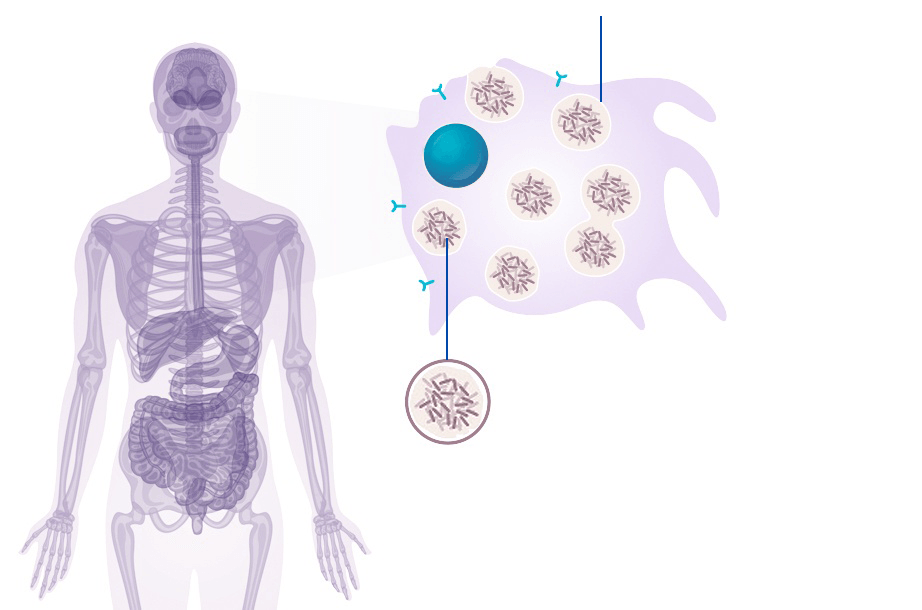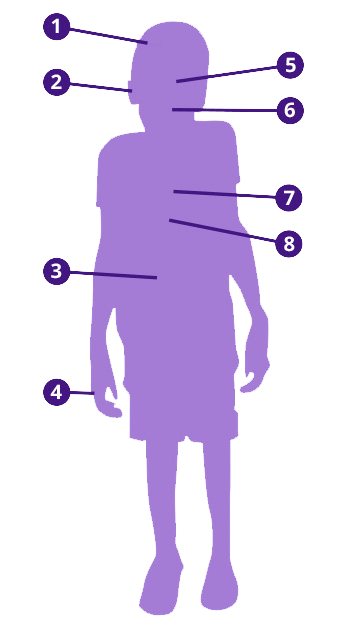What is MPS VII?
MPS VII is a rare, life-threatening lysosomal storage disorder1,2
MPS VII, also called Sly syndrome, is caused by mutations of the GUSB gene, which results in a deficiency of the β-glucuronidase enzyme.2,3
β-glucuronidase plays a key role in the breakdown of glycosaminoglycans (GAGs), previously called mucopolysaccharides. The inability to properly break down GAGs causes them to build up in the lysosomes.2,3
 nucleus
Lyosome
nucleus
Lyosome
Glycosaminoglycans (GAGs)
build up in the lysosomes of organs and tissues in patients with MPS VII. This buildup can lead to debilitating multi-organ dysfunction.2-4
Did you know?
Due to the variability of disease presentation, diagnosis of MPS VII can be delayed. It is important to test patients with suspected MPS VII at any age.4
MPS VII is a genetic disease inherited in an autosomal recessive manner5
 |  | ||
| Genetic carrier | Genetic carrier | ||
 |  |  |  |
| Noncarrier, not affected | Genetic carriers, not affected | Affected | |
Fewer than 1 in 1.000.000
people have MPS VII6
MPS VII is heterogeneous2,4
The wide spectrum of symptom severity and clinical presentation can significantly delay diagnosis.4
1. Neurological symptoms1
Developmental delay and intellectual disabillity
2. Ear, nose, and throat signs2
Coarse facial features, increased head circumference, short neck, coarse hair, ear and respiratory infections, enlarged tongue, and hearing loss
3. Gastrointestinal signs2
Hepatosplenomegaly, hernias, diarrhea, dysphagia, reflux, and colitis
4. Musculoskeletal issues2,7
Dysostosis multiplex, joint pain and stiffness, short stature, joint contracture, scoliosis, kyphosis, gibbus, knock-knee, curved fingers, and restricted mobility

5. Ophthalmological complications2
Corneal clouding, heavy eyebrows, visual impairment, and photosensitivity
6. Dental issues2
Abnormal dentition with small and widely spaced teeth and gingival hypertrophy
7. Cardiovascular signs2
Left ventricular hypertrophy, aortic insufficiency, mitral regurgitation, congestive cardiac failure, aortic stenosis, and thickened aortic and mitral valves
8. Pulmonary complications2,7
Decreased pulmonary function, obstructive airway disease, sleep apnea, and chronic bronchitis

1. Neurological symptoms1
Developmental delay and intellectual disabillity
2. Ear, nose, and throat signs2
Coarse facial features, increased head circumference, short neck, coarse hair, ear and respiratory infections, enlarged tongue, and hearing loss
3. Gastrointestinal signs2
Hepatosplenomegaly, hernias, diarrhea, dysphagia, reflux, and colitis
4. Musculoskeletal issues2,7
Dysostosis multiplex, joint pain and stiffness, short stature, joint contracture, scoliosis, kyphosis, gibbus, knock-knee, curved fingers, and restricted mobility
5. Ophthalmological complications2
Corneal clouding, heavy eyebrows, visual impairment, and photosensitivity
6. Dental issues2
Abnormal dentition with small and widely spaced teeth and gingival hypertrophy
7. Cardiovascular signs2
Left ventricular hypertrophy, aortic insufficiency, mitral regurgitation, congestive cardiac failure, aortic stenosis, and thickened aortic and mitral valves
8. Pulmonary complications2,7
Decreased pulmonary function, obstructive airway disease, sleep apnea, and chronic bronchitis
It is important to recognize the signs and symptoms of MPS VII. Early and accurate diagnosis and management may help to slow disease progression.4
MPS VII is a progressive disease1,2,5
MPS VII is a multisystemic, progressive disorder with a broad spectrum of clinical presentations. Signs and symptoms generally become more severe with age.1,2,5 Hip dysplasia and worsening pulmonary function are two of the progressive symptoms commonly observed in patients with MPS VII. In some cases, MPS VII patients may develop new signs and symptoms over time which may also progress.1,2,5
Potential MPS VII disease progression in different patients2,3

|
Some patients may develop spinal deformities requiring surgery |
Many patients may loose the ability to walk due to hip dysplasia |
Many patients may experience progressively worsening pulmonary function leading to oxygen dependence |
References: 1. National MPS Society. A Guide to Understanding MPS. Durham, NC: National MPS Society. https://mpssociety.org/cms/wp-content/uploads/2017/04/MPS_VII_2008.pdf. Accessed August 14, 2018. 2. Montaño AM, Lock-Hock N, Steiner RD, et al. Clinical course of sly syndrome (mucopolysaccharidosis type VII). J Med Genet. 2016;53(6):403-418. 3. Fox JE, Volpe L, Bullaro J, Kakkis ED, Sly WS. First human treatment with investigational rhGUS enzyme replacement therapy in an advanced stage MPS VII patient. Mol Genet Metab. 2015;114(2):203-208. 4. Lehman TJA, Miller N, Norquist B, Underhill L, Keutzer J. Diagnosis of the mucopolysaccharidoses. Rheumatology (Oxford). 2011;50(suppl 5):v41-v48. 5. Mucopolysaccharidosis type VII. National Institutes of Health Genetics Home Reference website. https://ghr.nlm.nih.gov/condition/mucopolysaccharidosis-type-vii. Accessed August 14, 2018. 6. Mucopolysaccharidosis type 7. Orpha.net rare diseases search website. https://www.orpha.net/consor/cgi-bin/Disease_Search.php?lng=EN&data_id=40&Disease_Disease_Search_diseaseGroup=Mucopolysaccharidosis-type-7&Disease_Disease_Search_diseaseType=Pat&Disease(s)/group%20of%20diseases=Mucopolysaccharidosis-type-7&title=Mucopolysaccharidosis-type-7&search=Disease_Search_Simple. Accessed August 14, 2018. 7. Cimaz R, Coppa GV, Koné-Paut I, et al. Joint contractures in the absence of inflammation may indicate mucopolysaccharidosis. Pediatr Rheumatol Online J. 2009;7:18.





